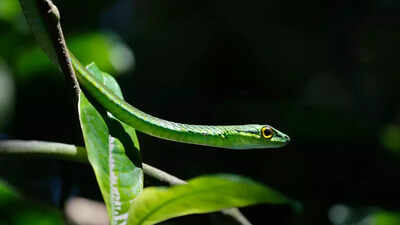ARTICLE AD BOX

When you walk through a lush rainforest and catch a glimpse of something long, thin, and brilliantly green moving in the trees, chances are you’ve just spotted a parrot snake. This reptile, scientifically known as Leptophis ahaetulla, is one of the most fascinating yet misunderstood creatures in Central and South America, according to the Mexican Terrestrial Life.org. With its striking emerald body and sharp eyes, it almost blends into the leaves, making it look like a natural part of the forest. But here’s the twist: it’s not entirely harmless. The parrot snake is mildly venomous, equipped with rear fangs that help it paralyse frogs, lizards, and small birds. While its bite isn’t a danger to humans, its appearance and hunting style make it a snake worth knowing about.Curious, agile, and perfectly adapted to life in the trees, this species is both a master of camouflage and a skilled hunter. Let’s dive deeper into what makes the parrot snake so unique, from its looks to its behaviour and where it lives.
Parrot snake fun facts you should know

The parrot snake (Leptophis ahaetulla) belongs to the colubrid family, which includes many non-venomous and mildly venomous snakes. What sets it apart is its long, slender body, often stretching up to 2 metres, though it remains surprisingly light. Its scales are usually bright green with shades of yellow or blue along the belly, giving it an almost glowing appearance when the sunlight hits.Despite being venomous, its fangs are located at the back of its mouth (rear-fanged), making it harder for the snake to deliver venom to large animals.
This is why humans rarely experience any issues, except mild swelling or irritation in rare bite cases. Another fun fact, its name comes from its bright parrot-like green colour, not from any connection to the bird itself.
Where the parrot snake lives

Parrot snakes are native to:
- Southern Mexico
- Central America
- Northern South America, including countries like Brazil, Colombia, and Venezuela
They thrive in humid, tropical environments and prefer staying high up in trees. Unlike ground-dwelling snakes, parrot snakes are arboreal, meaning their entire lifestyle revolves around climbing and moving through branches. Their slender bodies and incredible balance allow them to move gracefully among leaves, staying almost invisible to both predators and prey.
Behaviour and hunting style of parrot snakes
Parrot snakes are diurnal creatures, active during the day when their prey is most available. They rely on sharp eyesight and lightning-fast reflexes to strike at frogs, lizards, and small birds. Once they grab hold, their mild venom quickly immobilises the prey, making swallowing easier.What’s fascinating is their ability to move swiftly across thin branches without falling, almost like acrobats of the jungle. They don’t waste energy chasing prey; instead, they wait, observe, and then strike with precision.When threatened, these snakes aren’t highly aggressive. Instead of attacking, they often rely on intimidation, opening their mouths wide, flattening their bodies, or vibrating their tails to warn off predators.
Parrot snake's role in the ecosystem

Parrot snakes play a vital role in balancing their ecosystems. By feeding on frogs, lizards, and small birds, they help regulate populations and maintain biodiversity. They also serve as prey for larger birds and mammals, creating an important link in the food chain.This ecological balance is crucial, especially in rainforests where species are interdependent. Removing or losing snakes like the parrot snake could disrupt these natural cycles.
Are parrot snakes dangerous to humans?
The good news is that parrot snakes are not considered dangerous to humans. While their venom is effective on small animals, it’s too mild to cause harm to people. At most, a bite may cause temporary discomfort or minor swelling.In fact, most encounters with parrot snakes happen without incident, as they tend to avoid human activity. They are shy by nature and prefer slipping away into the trees rather than engaging.So, if you ever spot one during a trek in the tropics, consider yourself lucky; it’s a rare chance to witness one of the rainforest’s most fascinating residents.Also read| The rare prairie-chicken that looks like a rabbit: Nature’s unique wonder



.png)
.png)
.png)
















 2 hours ago
3
2 hours ago
3








 English (US) ·
English (US) ·